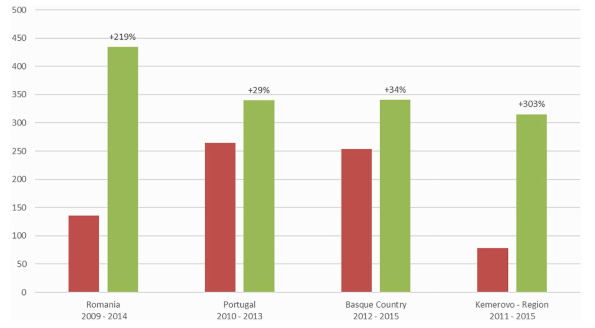Final results of the Stent for Life Economic Model are now published!
Developed to demonstrate the financial, economic and clinical benefit of timely STEMI admissions and primary PCI treatment, the Stent for Life (SFL) Economic Model project was run between 2009 and 2015 at the onset of the initiative in 4 different regions: Romania, Portugal, the Basque Country (Spain) and the Kemerovo region (Russian Federation).
Based on a decision tree model reflecting the real-life situation and incorporating pPCI rates and mortality as well as a cost analysis calculated by comparing the wage loss due to mortality and morbidity with the direct treatment cost of a STEMI for 4 treatment options – no reperfusion, thrombolytic only, pPCI and CABG – the SFL project, supported by its local partners (professional societies, health authorities and health service providers), resulted in a significant increase in the number of timely PCI procedures for those with STEMI. Consequently, when pPCI cases increased, there was a corresponding economic and cost savings which offset investments in devices, cath labs and interventional cardiologists.

Number of pPCI per million population at the start (red) and after (green) the program of the SFL initiative
In Romania, the SFL Economic Model (2009-2014) showed the number of STEMI pPCI grew from 136 to 434 per million population over the course of the project. The PCI % of timely admits was one of the drivers for the improvement, increasing from 20% in 2009 to 60% in 2014. Despite the addition of 6 cath labs among other investments, there was a net cost reduction of 40.4 million USD across the 6 years measured.
The SFL Economic Model run in Portugal (2010-2013) led to an increase of the STEMI pPCI from 264 to 340 per million population. On-time STEMI admissions also increased over the time-period. The net result of these improvements was a reduction of mortality of 414 lives and nearly 45.6 million USD of cost savings.
Over the course of the SFL initiative in the Basque Country, Spain (2012-2015), the pPCI rate per million population raised from an estimated 254 to 341 while the on-time admissions improved by 5 percentage points. Thanks to a relatively high GDP per capita and a low inflation rate, significant cost savings were achieved of approximately 2.8 million USD in an area of less than 700,000 people.
In the Kemerovo-Siberia region, Russia, the SFL Economic Model (2011-2015) achieved significant gains such as the rate of PCI as a % of on-time admissions that increased from 12 to 39% during the time-period, leading to a level of pPCI per million population similar to that of the other regions involved in the project. Although approximately 1.8 million USD were invested in cath labs and cardiologists, the productivity savings due to higher rates of PCI more than offset this amount resulting in cost savings of 4.7 million USD.
Full details and results of the project were published in the September edition of the European Heart Journal – Acute Cardiovascular Care. To access the original scientific paper, click here
For all existing and future members of the Stent-Save a Life! global initiative, the Stent for Life Economic Model scientific paper is considered as a great advocacy tool to convince governmental health authorities that not only the joint efforts of Stent-Save a Life! and their local partners can save lives, but also that systematic investments to improve the access of STEMI patients to guideline-coherent therapy is beneficial for the individual as well as for the society as a whole.






